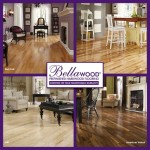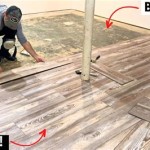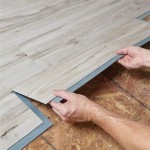Wood Flooring Tile: A Comprehensive Guide to Style and Functionality
Wood flooring tile, a popular alternative to traditional hardwood, offers a blend of aesthetic appeal and practical durability. These tiles, typically made of ceramic or porcelain, are designed to mimic the look and feel of natural wood, bringing warmth and character to interior spaces while providing the benefits of tile flooring. Examining the composition, installation, maintenance, and design options reveals the versatility of wood flooring tile and its suitability for various applications.
The creation of wood flooring tile involves sophisticated manufacturing processes. Ceramic tiles are generally made from clay mixtures fired at high temperatures. Porcelain tiles, a subset of ceramic, are crafted from a finer clay and fired at even higher temperatures, resulting in a denser and more durable product. The wood-grain patterns are applied using advanced printing technology, often incorporating high-definition imagery to replicate the intricate details of real wood, including knots, grains, and color variations. This printing technology allows for a wide range of wood species to be simulated, from classic oak and maple to exotic hardwoods like teak and bamboo.
The appeal of wood flooring tile lies in its ability to combine the aesthetic advantages of wood with the functional advantages of tile. Unlike natural wood, these tiles are resistant to moisture, making them suitable for bathrooms, kitchens, and basements where wood flooring would be susceptible to damage. They are also less prone to scratching, staining, and fading, making them a durable choice for high-traffic areas. The ease of maintenance is another significant advantage; wood flooring tile can be easily cleaned with simple household cleaners, eliminating the need for specialized wood care products.
Understanding the Benefits of Wood Flooring Tile
The selection of flooring material is a crucial decision in both residential and commercial design. Several factors contribute to the growing popularity of wood flooring tile, including its durability, versatility, and ease of maintenance. Examining these benefits in detail provides a clear understanding of why it has become a preferred flooring option for many.
Durability is a primary consideration for most property owners. Wood flooring tile, particularly porcelain, is exceptionally resistant to wear and tear. Its dense composition makes it less susceptible to scratches, dents, and chips compared to natural wood or laminate flooring. This durability is particularly important in areas with heavy foot traffic, such as hallways, entryways, and commercial spaces. The resistance to water damage is another key advantage. Unlike solid wood, wood flooring tile can withstand exposure to moisture without warping, swelling, or rotting.
The cleaning and maintenance of wood flooring tile are significantly simpler than that of traditional wood floors. Regular sweeping or vacuuming is typically sufficient to remove dirt and debris. For more thorough cleaning, a damp mop with a mild detergent can be used. There is no need for waxing, polishing, or refinishing, which are often required for maintaining the appearance of natural wood. This low-maintenance aspect of wood flooring tile makes it a cost-effective and convenient option for busy households and commercial settings.
Versatility in design is another important benefit. Wood flooring tile is available in a wide variety of colors, sizes, and patterns. It can mimic virtually any type of wood, from light-colored birch to dark-stained mahogany. The tiles can be arranged in various patterns, such as straight lay, herringbone, or chevron, to create unique and visually appealing designs. This versatility allows property owners to achieve the desired aesthetic while benefiting which the practicality of tile.
Installation Considerations for Wood Flooring Tile
Proper installation is essential for ensuring the longevity and performance of any flooring material, including wood flooring tile. While it can be a do-it-yourself project for experienced individuals, professional installation is generally recommended to avoid common pitfalls and ensure a flawless finish. Understanding the key steps and considerations in the installation process is crucial for a successful outcome.
Subfloor preparation is the first and most critical step. The subfloor must be clean, level, and structurally sound. Any imperfections, such as cracks or uneven areas, must be addressed before proceeding. Depending on the type of subfloor, this may involve patching cracks with a cement-based compound, applying a self-leveling underlayment, or reinforcing weak areas with additional support. A properly prepared subfloor provides a stable and even surface for the tiles, preventing future issues such as cracking or shifting.
Once the subfloor is prepared, the layout and design should be carefully planned. The placement of the first row of tiles is critical, as it sets the foundation for the rest of the installation. Using a chalk line to create straight and accurate guidelines is essential. The chosen pattern, whether it's a straight lay, staggered pattern, or more complex design, should be carefully considered to maximize visual appeal and minimize waste.
Applying the adhesive, or thin-set mortar, is another crucial step. The type of thin-set mortar should be specifically chosen for the type of tile being installed and the type of subfloor. The mortar should be applied evenly and in small sections, using a notched trowel to create ridges that provide optimal adhesion. The tiles should be firmly pressed into the mortar with a slight twisting motion to ensure good contact. Spacers should be used between the tiles to maintain consistent grout lines.
After the tiles have been installed and the mortar has cured, the grout can be applied. The grout fills the spaces between the tiles, providing a finished look and preventing water from seeping underneath. The type of grout should be selected based on the tile and the environment; for example, epoxy grout is often recommended for areas with high moisture exposure. The grout should be applied evenly and excess grout should be removed with a damp sponge. After the grout has cured, the tiles can be cleaned and sealed to protect against stains and moisture.
Design Applications and Style Options for Wood Flooring Tile
The aesthetic versatility of wood flooring tile allows for a wide range of design applications, from rustic farmhouse to modern minimalist. The ability to mimic different wood species and patterns, combined with the practical advantages of tile, makes it a suitable choice for various interior design styles. Exploring these design applications and styling options can help property owners find the perfect wood flooring tile to complement their aesthetic preferences.
For a rustic or farmhouse-style interior, wood flooring tile with a distressed or weathered look can be used. These tiles often feature knots, grains, and color variations that mimic the appearance of reclaimed wood. Wide planks and staggered patterns can further enhance the rustic aesthetic. Pairing these tiles with natural materials, such as exposed brick, stone, and wood furniture, can create a warm and inviting atmosphere.
In a modern or contemporary setting, wood flooring tile with a sleek and minimalist design can be used. These tiles often feature clean lines, subtle grains, and neutral colors, such as gray, beige, or light brown. Long, narrow planks and straight lay patterns can create a sense of spaciousness and sophistication. Combining these tiles with modern furniture, metallic accents, and abstract artwork can create a stylish and contemporary space.
For a traditional or classic interior, wood flooring tile with a rich and elegant design can be used. These tiles often mimic the appearance of high-end hardwoods, such as oak, maple, or walnut. Traditional plank sizes and patterns, such as herringbone or chevron, can add a touch of sophistication. Pairing these tiles with classic furniture, ornate detailing, and warm lighting can create a timeless and elegant atmosphere.
Beyond these specific styles, wood flooring tile can be used in a variety of other design applications. It can be used to create a seamless transition between indoor and outdoor spaces, as it is suitable for both interior and exterior use. It can also be used to create custom designs, such as borders, medallions, or patterns, to add a unique touch to any space. The versatility of wood flooring tile makes it a valuable tool for interior designers and property owners alike.

5 Wood Look Tile Flooring Ideas Lowe S

Wooden Floor Tiles Bathroom Kitchen Kajaria S No 1 Tile Co

How Does Wood Flooring Help To Protect The Environment

Wood Look Tile Flooring All You Need To Know Oasis

Wood Floor Tiles Vs Real Wooden Flooring Which Is Better

Wood Look Tile Why It Continues To Be A Trendsetter Empire Today Blog

How To Choose The Right Wood Look Tile Color Arizona

Colours Cotage Wood Grey Matt Effect Textured Porcelain Indoor Wall Floor Tile Pack Of 4 L 1200mm W 200mm Diy At B Q

Why You Must Choose Wood Floor Tiles Over Wooden Flooring

Daltile Baker Wood 6 In X 24 Walnut Glazed Porcelain Floor And Wall Tile 14 55 Sq Ft Case Bk10624hd1pr The Home Depot
Related Posts








